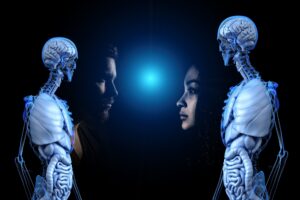Salutogenesis and Well-Being
The term “salutogenesis” is derived from the Latin salus meaning “health” and the Greek génesis meaning “origin”. It is an interpretative position of science that examines the possible development of health and pays attention to those factors that contribute to a state of well- being, rather than those that cause illness.
Since 1948, the World Health Organization (WHO) has stated that health is something more than the absence of disease; rather, it is a state of social, mental and physical well-being. In salutogenesis, health and illness are not, in fact, two mutually exclusive conditions, but two polar opposites on a continuous spectrum.
The concept of salutogenesis, as developed by the Israeli- American sociologist, Aaron Antonovsky (1997), foresees dynamic interaction between protective factors and stressors. Health, which is in no way static, must, therefore, be established, and maintained by overcoming daily difficulties, as a process in continuous development, with particular attention paid to the resources available for personal protection.
How, then, might we move towards the pole that represents health?
Two foundational concepts for interpretation
One extraordinary, indispensable paradigm through which we might achieve health, and with which to interpret the multiplicity of social, cultural, relational, psychic and physical resources available, is Complexity.
 “Complexity” derives from cum plexum meaning “interwoven”, or, more literally, “with knots”, as in those found in a carpet, which may not be unravelled without losing sight of the whole picture that they allow. It differs from the term “complicated”, derived from cum plicum, literally meaning “with folds”, which must be unfolded in order to be interpreted and understood, so that the first pieces seen must be separated and put back together again before it is possible to understand the whole.
“Complexity” derives from cum plexum meaning “interwoven”, or, more literally, “with knots”, as in those found in a carpet, which may not be unravelled without losing sight of the whole picture that they allow. It differs from the term “complicated”, derived from cum plicum, literally meaning “with folds”, which must be unfolded in order to be interpreted and understood, so that the first pieces seen must be separated and put back together again before it is possible to understand the whole.
On the one hand, it is necessary to apply a systemic approach that “the whole is greater than the sum of its parts” (Bertalanffy, 1971). This permits an interpretative reading of salutogenesis in the entirety of its connections. On the other hand, it is necessary to apply an emergentist approach. This allows us to ask ourselves what the evolution over time of the system of connections might be and how the system modifies itself when we apply “salutogenic appropriacy”.
Complexity is, thus, a new, indispensable paradigm in order to see and read a complex living system in its polyhedric entirety. However, it is a paradigm that is also capable of including the complex living system which sees and reads.
Complexity is Intelligent Inclusion, of the body and its senses. It is the inclusion of time and memories, of the life-story and the various rhythms experienced, in the interpretation of a complex living system, be that a living-body person, a living-body society, or a living-body planet (Tiezzi, 1996).
Complexity is perceiving the hidden connections among the phenomena of Life and reading them from, and in, their emergence. The Emergentist current of thought (Mancuso, 2018) offers an evolutive interpretation of complex living systems, which concerns phylogenesis and the origins of the species, but also concerns ontogenesis, which regards the formation of the single individual.
This evolutive world-view is primarily defined from the perspective of a bottom-up direction, but with circularity which is completed by a top-down return.
In this way, each person has their own specific life-story, and, although another person might have had very similar experiences, they will never be exactly the same. Self individuation may also be seen as unique and indivisible.
Every one of us is more than just our own genetic heritage. Every one of us has our own unrepeatable personality, which cannot be separated from our Corporeity or from our history of specific biological-biographical relationships that have been marked and incised into our corporeity.
Evolution represents a progressive increase in complexity and in negentropy (Schroedinger, 1995), until reaching awareness of self and the capacity to bring out and express our elan vital. According to Ilya Prigogine, Nobel Prize- winner for physics, “far from equilibrium (0 = entropic zero), energy and matter begin to see” (Prigogine,1996, pg. 2).
Another equally-safe direction from which to approach the question is Body-to-Mind.
Body-to-Mind summarises and defines the negentropic, complex, evolutive direction of the person.
Today the Body is cast by neuroscience, to put it phenomenonologically, in Life’s project, in all its visibility and evidence, so as to be revealed to prevailing disembodiment, in a liquified society at risk of rarefaction, by the acceleration of external cognitive time, with the consequent theft of people’s internal, affective, relational time. It is a society which, absolutely, must meta-communicate with its own dominant Trait Mind (as defined below) about the role of mankind and our place in existence.
The Body tells us, with its historical narration, about the comprehensibility of the Body-to-Mind direction.
It has its own solid, extraordinary “grammar system”, resting on intelligent foundations, which are therefore capable of reading and of being read. The intelligence of the body is stratified in its adaptive recombinations across the whole time of phylogenisis and is summarised in the period of ontogenesis, so as to permit the progressive complexity of the mind.
Complexity of the Mind
. . . a body that not only informs us about pre-subjective and pre- linguistic perception-sensations but also about emotions and the subjective thoughts connected to them…
. . . a body that informs us “where we are” in space and time, and “what we stand upon” in terms of our observative positions and our possible, sustainable horizons. . .
. . . a body that adds intercorporeity to intersubjectivity, permitting possible activations which, from the peripheral-surface of the “outside”, pass through the cortical-spinal pathways, reaching the depth-centrality of the “inside”
(Gallese, 2006).
Body-to-Mind continuity becomes ever clearer
Research in psychotherapy is ever-more focused on the embodied mind  (“cognitive processes cannot be confined to the brain”), on the enactive mind (“the pairing of a sensory-motor organism and the environment is the founding element for cognition”), and on the trait mind (“a complex functional system which connects and coordinates the organisation of an evolutive stage, the prevalent relational bodily level, the trait patterns incised by the intersubjective- intercorporeal relationships and their respective modulations by neuromediators in the corresponding brain areas”) (Ferri, 2017).
(“cognitive processes cannot be confined to the brain”), on the enactive mind (“the pairing of a sensory-motor organism and the environment is the founding element for cognition”), and on the trait mind (“a complex functional system which connects and coordinates the organisation of an evolutive stage, the prevalent relational bodily level, the trait patterns incised by the intersubjective- intercorporeal relationships and their respective modulations by neuromediators in the corresponding brain areas”) (Ferri, 2017).
These are embodied, enactive, trait minds that are stratified and imbricated from the body to the mind, from pre-subjective intrauterine time onwards, so as to construct the apartment building of our personalities.
In the body psychotherapy setting, this complex body-to-mind interpretation permits levels of refined precise analytical-therapeutic appropriacy, starting right from the periphery in those specific apartments, or floors, in this building, which present dysfunctional nodes (plexum), with bodily activations expressed by ad hoc, ontogenetic movements (Ferri-S.I.A.R., Character-Analytical Vegetotherapy), which regenerate health and well-being for the person.
Two operational suggestions for daily life
It is both fundamental and beautiful that we are becoming aware of the body-to-mind continuity of the self-subject, integrating our own life stories from the very beginning of the universe itself to our lives today, with our own feelings and emotions and our own capacities for resiliance and sustainability, from which we derive our own negentropic rhythms.
It is also certainly fundamental and beautiful that we are becoming aware that we are immersed in the vast living field which our biosphere represents, emerging, as it does, from a vaster cosmological history and a negentropic geometric location, which is a cradle of the great magic of life. In other words, it means we are becoming aware of our “Terrestrial Commonality” (Morin, 2003).
But, from a practical perspective, what can a complex body-to-mind interpretation suggest in our daily lives for our well-being and to generate health?
We should learn from the pleasure we derive from the activation of our Mu-receptors by beauty, meant as “the splendour of truth” (Mancuso, 2018), which is a profound, precious experience and which causes and permits the emergence of enthusiasm within us. The word “enthusiasm” is derived from the Greek en, meaning “within” and thèos meaning God (the God within). However, even when those same receptors are activated by psychotherapy in different key areas of the brain, it is an effective activation that is almost on the same level as pharmacological treatment for deep depression with citalopram (Fava, 2015). Our Mu-receptors can suggest some important considerations on, for example, our fitness and on a diet favouring neurogenesis, which is the process by which new neurons are formed from stem-cells.
Doing physical exercise and aerobic exercise in particular, for four to five hours a week (walking, running or dancing, for example) promotes the proliferation of neuronal precursors and, in particular, notably increases the size of the left part of the hippocampus. Meanwhile, cognitive stimuli and learning (never stop studying!) promote the recruitment and survival of newly-formed cells (this sequence clearly reflects the directional pattern of our body- to-mind process).
Furthermore, aerobic activity correlates with the capacity to reduce stress-hormone levels, like adrenaline and cortisol, and improves mood. It also improves blood- flow, carrying a greater quantity of oxygen to the brain— a fundamental nutriment that supports cognitive functions, working memory, selective attention, and executive brain functions.
 Physical exercise, like a reduced-calorie diet, increases the levels of Brain-Derived Neurotrophic Factors (BDNF) – neurotrophins that promote the growth and development of immature neurons increasing their survival, as well as improving the functionality of adult neurons and maintaining synaptic connections.
Physical exercise, like a reduced-calorie diet, increases the levels of Brain-Derived Neurotrophic Factors (BDNF) – neurotrophins that promote the growth and development of immature neurons increasing their survival, as well as improving the functionality of adult neurons and maintaining synaptic connections.
Appropriate diet, and hydration with at least two liters of water daily, allow the individual to move towards the pole of health and neurogenesis, increasing neurotrophin levels.
In particular by:
• favouring a natural diet that is low in animal fats;
• consuming seasonal, organic fruit and vegetables, respecting the “food rainbow” (for example: red oranges, orange carrots, yellow lemons, green peppers, blueberries, violet cabbage and white melon)
• eating unrefined, wholemeal carbohydrates (and not industrially- produced, refined carbohydrates);
• consuming foods with a low glycemic index;
• having a savoury breakfast;
• ensuring there are a variety of cereals in the diet (such as: barley, spelt, rice, amaranth grain, quinoa etc.);
• paying attention to the quality and origin of dietary fats and proteins (dried fruit and oilseeds, for example, may
be used as alternatives to animal fats, while plant proteins found in legumes,
for example, may be alternated with animal proteins from white meat or fish);
• ensuring balanced consumption of major food-categories (carbohydrates, protein and fats);
• maintaining body-fat percentage within the normal range for gender, age and daily activity according to BMI;
• avoiding alcoholic, carbonated and sugary drinks;
• minimising simple sugars and salt consumption (as an alternative, enhancing flavours, perhaps, through the use of herbs and spices).
A final consideration
The possible future for people and for life is born from respect for the self, respect for their sustainability, respect for their limits,
respect for the rhythms of their internal time in pulsating-equilibrium with external time. It is born from a profound respect for others, for relationships and for the living planet Earth.
Our possible future can only be born with humility coming from those eyes able to read Intelligent Complexity that is greater than us and than our cognition. It shall also be born from the intelligent direction that the wisdom deposited in our Body-Logos (Ferri, 2017) grants us with its negentropic responses to the attention we pay to ourselves in our daily lives.
REFERENCES
Antonovsky, A. (1997). Salutogenese: Zur entmystifizierung der gesundheit. Berlin Dgvt Verlag Ed.
Bauman, Z. (2003). Modernita liquida. Bari, Laterza Ed.
Bertalanffy, L. V. (1971). Teoria generale dei sistemi. Torino, Isedi Ed.
Damasio, A. (2012). Il Se viene alla Mente. Milano, Adelphi Ed.
Ferri, G. (2016). The Mind…the embodied mind…the enactive mind…the trait mind. Somatic Psychotherapy Today, 6 (1).
Fava, M. (2015). Implications of a biosignature study of the placebo response in major depressive disorder. JAMA Psychiatry, 71 (11): 1073-1074. doi:10.1001/jamapsychiatry.2015.1727
Ferri, G. (2017). Body sense, eBook, Alpes Ed.
Ferri, G., & Cimini G. (2018). Psychopathology and character, eBook, Alpes Ed.
Ferri, G., & Paiva M.J. (2019). Primari object relationship: A new reading. Somatic Psychotherapy Today, 9 (1).
Gallese, V., Migone, P., & Eagle, M.N. (2006). La simulazione incarnata: i neuroni specchio, le basi neurofisiologiche dell’intersoggettivita’ e alcune implicazioni per la psicoanalisi. Ed.unipr.it.
Mancuso, V. (2018). La via della bellezza. Milano, Garzanti Ed.
Morin, E. (2003). Madrid la identitad humana catedra Ed.
Mosconi, L. (2018). Nutrire il cervello. Milano. Mondadori Ed. Navarro, F. La Somatopsicodinamica. (1988). Il discobolo Ed.
Pecina, M., Bohnert, M.S.B., & Skiara, M. (2015). Association between placebo activated neural systems and antidepressant response: Neurochemistry of placebo effects in major depression. JAMA Psychiatry, 72 (11): 1087-1094. doi:10.1001/jamapsychiatry.2015.1335
Prigogine, I. (1996). Preface. In, Tiezzi, E., Fermare il Tempo (p.2). Milan, Italy: Raffaello Cortina Editore.
Prigogine, I., & Stengers, I. (1981). La nuova alleanza- metamorfosi della scienza. Torino, Italy: Einaudi Editore.
Porges. S. (2014). La teoria polivagale. Roma, Fioriti G. Ed.
Reich, W. (1932). Analisi del carattere. Milano, SugarCo Ed.
Schrodinger, E. (1995). Che cos’e la vita? Milano, Adelphi Ed.
Tiezzi, E. (1996). Fermare il Tempo. Milano, Cortina Ed.
Weintraub, K. (2019). Nuovi neuroni crescono anche nel cervello adulto. Scientific American.








